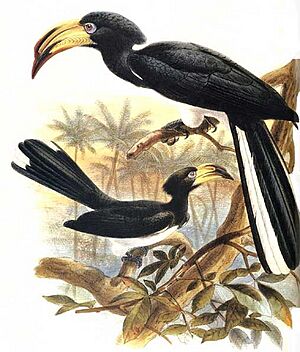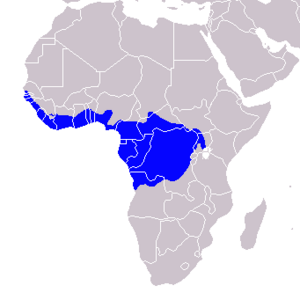Congo pied hornbill facts for kids
Quick facts for kids Congo pied hornbill |
|
|---|---|
 |
|
| Conservation status | |
| Scientific classification | |
| Genus: |
Lophoceros
|
| Species: |
fasciatus
|
 |
|
| Range of Congo and West Africa pied hornbill | |
| Synonyms | |
|
Tockus fasciatus |
|
The Congo pied hornbill (Lophoceros fasciatus), also known as the African pied hornbill, is a special bird. It belongs to the hornbill family, which are tropical birds found in Africa and Asia. These birds are known for their unique beaks.
You can find the Congo pied hornbill living in many parts of central Africa. Their home stretches from countries like The Gambia to western Uganda and northern Angola. They mostly live in forests. Female hornbills lay up to four white eggs inside a tree hole. During this time, the female seals herself inside the nest. She uses a special "cement" made from mud, droppings, and fruit pulp. There's only a small opening left. This tiny hole is just big enough for the male hornbill to pass food to the mother and her chicks.
Contents
What Does a Congo Pied Hornbill Look Like?
This is a fairly large bird, growing to about 54 centimeters (21 inches) long. Most of its feathers are black. However, it has a white belly and white tips on its tail feathers.
Its Unique Beak
The Congo pied hornbill has a long, curved beak that is black and yellow. On top of its beak, it has a medium-sized growth called a casque. Both male and female hornbills have this casque. However, the female's casque is usually smaller than the male's. Young hornbills are not as brightly colored. Their beaks are smaller, and they don't have a casque yet. When these birds fly, their flight looks wavy, going up and down.
How Do Congo Pied Hornbills Behave?
The Congo pied hornbill eats both plants and animals. This means it is an omnivore. Its diet mainly includes fruits and insects. They usually find their food while high up in the trees. They especially like to eat from oil palm trees.
Sounds and Social Life
These birds are quite easy to spot and often live in groups. You can tell they are around by their loud, whistling call. It sounds like pii-pii-pii-pii-.
Nesting Habits
When the baby chicks and the mother bird grow too big for the nest, the mother breaks out of the sealed tree hole. She then helps to rebuild the wall of the nest. After this, both parents work together to feed their growing chicks.


